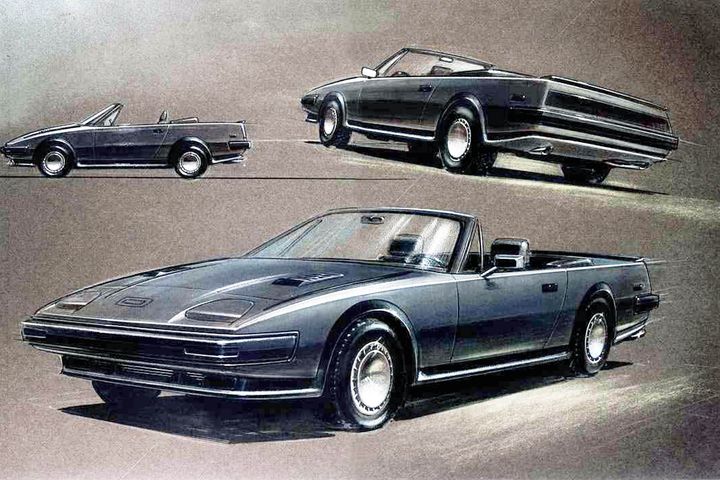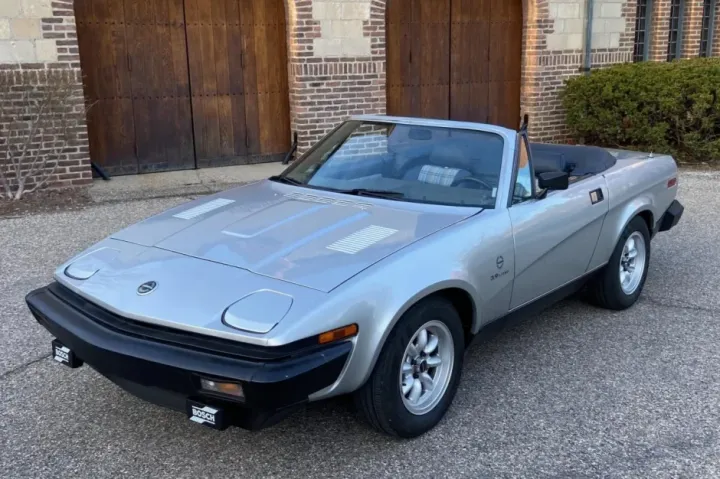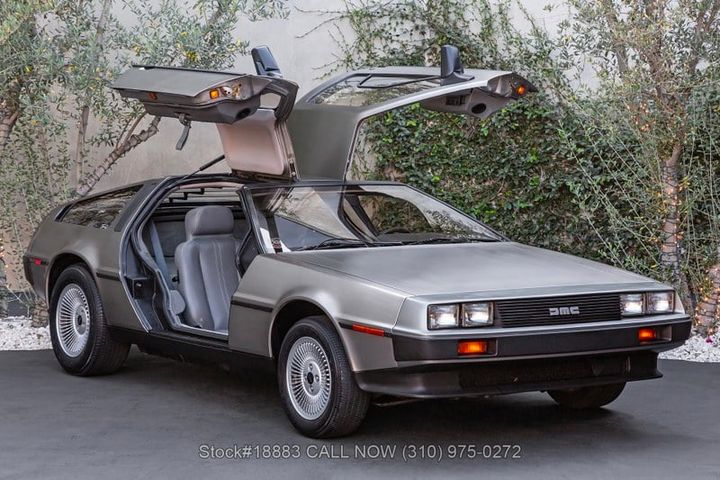Healey, DeLorean, TR7
Discussion
The Lost Healey Revival: Dunmurry Motor Company and Britain's Missed Sports Car Renaissance
When John DeLorean's company (DMC) collapsed in 1982, the brand-new Dunmurry factory outside Belfast, one of the most modern car plants in Europe, stood silent. Hundreds of millions of pounds of British taxpayer money had gone into the project, and thousands of Northern Irish jobs hung in the balance. There was a credible plan to save both the factory and Britain's dwindling sports-car tradition; relaunch the business as the Dunmurry Motor Company (DMC), keeping the iconic logo but rebranding the cars under the Healey name.
The TR7/8 twins were already developed into attractive advanced looking soft tops with the hard top dropped. British Leyland cancelled them as a part of its deal with Honda, prior to the DeLorean crash. The Dunmurry Motor Company proposed to restart production of the two Triumph models with few changes, alongside continued production of the DeLorean DMC-12, with all three produced in the DeLorean plant.
The Plan: A Three-Car Healey Range
The strategy was elegant in its simplicity. Using existing designs, tooling, and engines, the new company could have restarted production quickly and cheaply. The range would have been:
Healey Gullwing: the original DeLorean DMC-12, largely unchanged, serving as the futuristic halo car.
Healey 2000: based on the Triumph TR7 convertible, powered with the proven Saab/TR7 slant-four engine, with its controversial side creases smoothed out.
Healey 3500: based on the Triumph TR8 convertible, powered by the Rover 3.5-litre V8, with its controversial side creases smoothed out. Aimed squarely at the lucrative US market.
The TR7/8 twins were already developed into attractive soft tops, but British Leyland had just cancelled them as part of its deal with Honda. Selling the tooling to Dunmurry Motor Company would have brought BL a modest royalty while allowing the cars a second life.
Why Healey?
The Healey name carried enormous cachet, especially in North America. The Austin-Healey sports cars of the 1950s and 60s had been icons of affordable performance, and the Healey family were willing to lend their name. Healey gave the cars heritage and legitimacy that DeLorean lacked, positioning them not as oddities but as the continuation of a proud British sports-car lineage.
Government Support Then Withdrawal
Early signs were promising. Industry Secretary Peter Prior saw the project as a way to preserve jobs in Northern Ireland and the Midlands. The receivers of DeLorean were eager for a credible buyer. The unions were supportive, recognising the chance to avoid another industrial graveyard, BL wanted the deal to sell tooling and earn some royalties.
But approval required one final nod from Margaret Thatcher's government. And here, the plan died. Despite assurances that the new company had secured private funding and required no further state money, Thatcher, wary after the DeLorean scandal and determined to end government involvement in failing car ventures said ''no''.
The proposal was quietly shelved. The Dunmurry plant was mothballed, the TR7/8 tooling scrapped, and another piece of Britain's sports-car heritage was lost.
What Might Have Been
A Tragic Missed Opportunity
The story of the Dunmurry Motor Company is a reminder of how politics, timing, and perception can derail even the most workable industrial rescue. Thatcher saw only another DeLorean bailout; in fact, she was turning away a privately backed plan that might have kept Britain at the forefront of sports-car design.
Today, enthusiasts can only speculate what a Healey 2000, 3500, and Gullwing might have meant for British motoring. Instead of a Japanese roadster leading the revival, the world might have rediscovered its love of sports cars through a trio built in Belfast under the Healey badge.

TR7/8 with restyled sides to be renamed Healey 2000 & 3500

TR7 to be renamed Healey 2000, with side creases removed

DeLorean DMC-12 to be renamed Healey Gullwing
https://www.aronline.co.uk/concepts-and-prototypes...
When John DeLorean's company (DMC) collapsed in 1982, the brand-new Dunmurry factory outside Belfast, one of the most modern car plants in Europe, stood silent. Hundreds of millions of pounds of British taxpayer money had gone into the project, and thousands of Northern Irish jobs hung in the balance. There was a credible plan to save both the factory and Britain's dwindling sports-car tradition; relaunch the business as the Dunmurry Motor Company (DMC), keeping the iconic logo but rebranding the cars under the Healey name.
The TR7/8 twins were already developed into attractive advanced looking soft tops with the hard top dropped. British Leyland cancelled them as a part of its deal with Honda, prior to the DeLorean crash. The Dunmurry Motor Company proposed to restart production of the two Triumph models with few changes, alongside continued production of the DeLorean DMC-12, with all three produced in the DeLorean plant.
The Plan: A Three-Car Healey Range
The strategy was elegant in its simplicity. Using existing designs, tooling, and engines, the new company could have restarted production quickly and cheaply. The range would have been:
Healey Gullwing: the original DeLorean DMC-12, largely unchanged, serving as the futuristic halo car.
Healey 2000: based on the Triumph TR7 convertible, powered with the proven Saab/TR7 slant-four engine, with its controversial side creases smoothed out.
Healey 3500: based on the Triumph TR8 convertible, powered by the Rover 3.5-litre V8, with its controversial side creases smoothed out. Aimed squarely at the lucrative US market.
The TR7/8 twins were already developed into attractive soft tops, but British Leyland had just cancelled them as part of its deal with Honda. Selling the tooling to Dunmurry Motor Company would have brought BL a modest royalty while allowing the cars a second life.
Why Healey?
The Healey name carried enormous cachet, especially in North America. The Austin-Healey sports cars of the 1950s and 60s had been icons of affordable performance, and the Healey family were willing to lend their name. Healey gave the cars heritage and legitimacy that DeLorean lacked, positioning them not as oddities but as the continuation of a proud British sports-car lineage.
Government Support Then Withdrawal
Early signs were promising. Industry Secretary Peter Prior saw the project as a way to preserve jobs in Northern Ireland and the Midlands. The receivers of DeLorean were eager for a credible buyer. The unions were supportive, recognising the chance to avoid another industrial graveyard, BL wanted the deal to sell tooling and earn some royalties.
But approval required one final nod from Margaret Thatcher's government. And here, the plan died. Despite assurances that the new company had secured private funding and required no further state money, Thatcher, wary after the DeLorean scandal and determined to end government involvement in failing car ventures said ''no''.
The proposal was quietly shelved. The Dunmurry plant was mothballed, the TR7/8 tooling scrapped, and another piece of Britain's sports-car heritage was lost.
What Might Have Been
- Had the Healey range gone ahead, the outcome could have been striking:
- Jobs in Northern Ireland would have been safeguarded through the 1980s.
- Britain would have kept a foothold in the global sports-car market just as Japan prepared to reinvent it with the Mazda MX-5 in 1989.
- The Rover V8-powered Healey 3500 could have been a transatlantic hit, keeping alive the tradition of muscular British roadsters.
- The DeLorean-based Healey Gullwing might have avoided the stigma of scandal, becoming a quirky but respected exotic.
A Tragic Missed Opportunity
The story of the Dunmurry Motor Company is a reminder of how politics, timing, and perception can derail even the most workable industrial rescue. Thatcher saw only another DeLorean bailout; in fact, she was turning away a privately backed plan that might have kept Britain at the forefront of sports-car design.
Today, enthusiasts can only speculate what a Healey 2000, 3500, and Gullwing might have meant for British motoring. Instead of a Japanese roadster leading the revival, the world might have rediscovered its love of sports cars through a trio built in Belfast under the Healey badge.
TR7/8 with restyled sides to be renamed Healey 2000 & 3500
TR7 to be renamed Healey 2000, with side creases removed
DeLorean DMC-12 to be renamed Healey Gullwing
https://www.aronline.co.uk/concepts-and-prototypes...
Edited by RayTay on Tuesday 7th October 15:02
Interesting but a lot of fantasy. Especially this:-
BL had the TR7/8 which had matured into the attractive soft top - in their wisdom they cancelled it. The reason was a link up with Honda.
The reason everyone gives for the ceasing of TR7/8 production was the much stronger dollar, meaning that the cars wouldn't sell for profitable money in the USA.
The bumpers on the TR7 were for the USA market crash testing. So redesigning them would have closed the USA market off.
BL had the TR7/8 which had matured into the attractive soft top - in their wisdom they cancelled it. The reason was a link up with Honda.
The reason everyone gives for the ceasing of TR7/8 production was the much stronger dollar, meaning that the cars wouldn't sell for profitable money in the USA.
The bumpers on the TR7 were for the USA market crash testing. So redesigning them would have closed the USA market off.
tr7v8 said:
Interesting but a lot of fantasy. Especially this:-
BL had the TR7/8 which had matured into the attractive soft top - in their wisdom they cancelled it. The reason was a link up with Honda.
The reason everyone gives for the ceasing of TR7/8 production was the much stronger dollar, meaning that the cars wouldn't sell for profitable money in the USA.
The bumpers on the TR7 were for the USA market crash testing. So redesigning them would have closed the USA market off.
I gave the link written by one of the management buyout team. He said as a DMC Healey they were to change the bumpers. The dollar was a problem but they assessed the exchange rate would change by the time they had purchased the company, tooled up, established dealers and had the cars in full production. The car was aimed at a world market not primarily the USA, so as not to put all in one fickle basket.BL had the TR7/8 which had matured into the attractive soft top - in their wisdom they cancelled it. The reason was a link up with Honda.
The reason everyone gives for the ceasing of TR7/8 production was the much stronger dollar, meaning that the cars wouldn't sell for profitable money in the USA.
The bumpers on the TR7 were for the USA market crash testing. So redesigning them would have closed the USA market off.
There were waiting lists for the TR8 soft top in the USA. The TR7 hardtop was dropped with only the attractive soft top remaining which was improved. The 5 speed gearbox and improved brakes and suspension from the Rover SD-1 transformed the car. The brands reputation was fine by the early eighties as the better looking soft tops had arrived with glitches ironed out. These improvements would be a part of the DMC Healey models.
This is a good retrospective view of the TR7 soft top car.
https://www.youtube.com/watch?v=6mzqlUewLEE&t=...
The Gullwing initially would remain identical except for baging. I recall reading the TR7 curved side crease removal may have had a straight sharper angular crease giving an impression more like the side of the Spitfire between its wheels.
Edited by RayTay on Friday 26th September 11:14
Gassing Station | Classic Cars and Yesterday's Heroes | Top of Page | What's New | My Stuff



